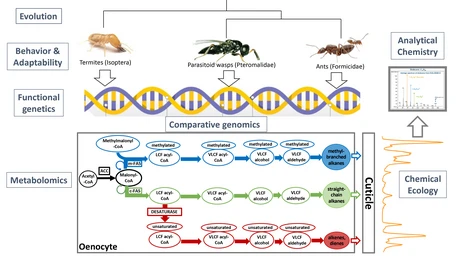Jan Buellesbach

Evolution of Chemical Communication
Research Department Life Science Systems
Technische Universität München
Hans-Carl-von-Carlowitz-Platz 2
D-85354 Freising-Weihenstephan
Room: 1.2.1.12
Email: jan.buellesbach@tum.de
ORCID: 0000-0001-8493-692X
Research interest
One of the fundamental questions in evolutionary biology is understanding the mechanisms underlying the origin of new species. The development and maintenance of barriers to interspecific reproduction are considered major driving forces behind speciation. Variations in sexual signaling can significantly contribute to reproductive isolation, as they preserve species-specific communication systems and facilitate precise mate recognition, preventing hybridization and reinforcing evolutionary divergence. My research focuses on the evolution of species- and sex-specific chemical signaling systems in insects and their impact on behavioral interactions, reproductive isolation, and environmental adaptation. This interdisciplinary approach integrates evolutionary biology, chemical ecology, analytical chemistry, functional genetics, comparative genomics, and behavioral ecology. By bridging these diverse fields, my research aims to uncover how chemical signaling shapes evolutionary trajectories, ultimately contributing to a deeper understanding of biodiversity and species formation. My research has repeatedly demonstrated that complex chemical blends — particularly cuticular hydrocarbons (CHCs) — exhibit varying degrees of species specificity, shaping behavioral interactions and evolutionary trajectories. This has also allowed for valuable conclusions on how biologically relevant information is chemically encoded in complex chemical profiles, how this in turn elicits behavioral changes in the perceivers, and how the signaling properties are governed genetically.
Curriculum Vitae
Since 2025: Heisenberg associate professor at Technical University of Munich, Freising, Germany
2024 - 2025: Guest research fellowship at the Institute of Zoology, Chinese Academy of Sciences, Beijing, China
2023: Venia legendi (“Habilitation”) in Evolutionary Chemical Ecology at the University of Münster, Germany
2018 - 2024: Assistant professor at the Institute for Evolution and Biodiversity at the University of Münster, Germany
2016 - 2018: Research scholar at the Department of Environmental Science, Policy, & Management, University of California, Berkeley, USA
2013 - 2016: Scientific manager of the Excellence Jena Graduate School for Microbial Communication, Jena, Germany
2011 - 2012: Postdoctoral research scholar at the Department of Entomology, North Carolina State University, USA
2011: PhD in Evolutionary biology, Spemann Graduate School for Biology and Medicine, University of Freiburg, Germany
2007 - 2010: Research associate at the Department of Evolutionary Biology and Animal Ecology, University of Freiburg, Germany and at the School of Life Sciences, Arizona State University, Tempe, USA
Publications
Sun W., Clara Clinder, Mohammed Errbii, Lukas Schrader, Gadau J., Buellesbach J. "The impact of a fatty acid synthase gene in regulating a multifunctional trait essential for survival and sexual communication", in prep for second submission to PLoS Genetics
Wang Q., Jiang H., Zheng H., Wu R., Zhang T., Wu J., Wang D., Guo S., Wang J., Wu H., Tang T., Buellesbach J. et al. Symbiont-mediated resistance to pyrethroids in Aedes mosquitoes, submitted, Nature
Sun W., Fischer M., Tzipin A., Privman E., Buellesbach J. "Species-specific sex pheromone variation and its impact on reproductive isolation: From phenotypic to genomic architecture", submitted, PNAS
Pohl M., Laukamp T., Caspers M., Paczkowski S., Buellesbach J. “Behavioral, chemical and genetic evidence for a cryptic species complex in carpenter ants from the ivory coast”, submitted, Functional Ecology
Buellesbach J., Cash E., Schmitt T. (2025) “Communication, insects”, in “Encyclopedia of Reproduction, Third Edition”, Volume 6, Elsevier Science Publishing Co Inc, San Diego, USA
Vonolfen M.C., Meyer zu Altenschildesche F.L, Nam H.-J., Brodesser S., Gyenis A., Buellesbach J., Lam G., Thummel C.S., Storelli G. (2024) Drosophila HNF4 acts in distinct tissues to direct a switch between lipid storage and export in the gut, Developmental Cell , 43(9), 114693, 10.1016/j.celrep.2024.114693
Golian M., Friedman D., Harrison M., McMahon D., Buellesbach J. (2024) “Chemical and transcriptomic diversity do not correlate with ascending levels of social complexity in the insect order Blattodea”, Ecology & Evolution, 14(8): e70063
Esparza-Mora M.A., Mazumdar T., Jiang S., Radek R., Thiem, J.N., Feng L., Petrašiūnaitė V., Banasiak R., Golian M., Gleske M., Lucas C., Springer A., Buellesbach J., McMahon D. (2023) “Defensive behavior is linked to altered surface chemistry following infection in a termite society”, Scientific Reports, 13, 20606, 10.1038/s41598-023-42947-9
- Sun W., Lange M., Gadau J., Buellesbach J. (2023) “Decoding the genetic and chemical basis of sexual attractiveness in parasitic wasps“, eLife, 12:e86182, 10.7554/eLife.86182
- Liu Y., Heath J.J., Zhanga S., van Wijk M., Wanga G., Buellesbach J., Wada-Katsumata A., Groot A.T., Schal C., (2023) “Endogenous and plant-derived courtship signals in male moths", Current Biology, 33(16): 3529-3535, 10.1016/j.cub.2023.07.010
Buellesbach J., Lammers M., van de Belt J., Pannebakker B. (2023) “Chemical and population genetic analysis show no evidence of ecotype formation in a European population of the parasitoid wasp Nasonia vitripennis”, Frontiers in Ecology and Evolution, 11: 10.3389/fevo.2023.1232639
Drakula M., Buellesbach J., Gadau J., Schrader L. (2023) “The role of cuticular hydrocarbons in intraspecific aggression in the invasive ant Cardiocondyla obscurior”, Myrmecological News, 33: 187-196, 10.25849/myrmecol.news_033:187
Whyte B., Sandidge R., Buellesbach J., Cash E., Scheckel K., Gibson J.D., Tsutsui N. (2023) “The role of body size and cuticular hydrocarbons in the desiccation resistance of invasive Argentine ants (Linepithema humile)”, Journal of Experimental Biology, 226 (16): jeb245578, 10.1242/jeb.245578
Buellesbach J.*, Rinke J.*, Thomas, J.M., Reuter L., Hartmann V., Pohl M., Gadau J., Ernst U.R. (2023) “Worker policing independent of strikingly different egg chemotypes in carpenter ants”, (*Authors contributed equally), Evolutionary Ecology, 37: 815–834, 10.1007/s10682-023-10245-5
Ostwald, M., Tretter S., Buellesbach J., Gadau J., Ernst U.R., Fewell, J. (2023) “Chemical variation and differences in desiccation resistance between haplometrotic and pleometrotic populations of the ant Pogonomyrmex californicus”, Journal of Comparative Physiology B, 193(3): 261–269
Buellesbach J., Holze H., Schrader L., Liebig J., Schmitt T., Gadau J., Niehuis, O. (2022) “Genetic and genomic architecture of species-specific cuticular hydrocarbon variation in parasitoid wasps”. Proceedings of the Royal Society B, 289(1976): 20220336
Leung, K., Beukeboom, L.W., Buellesbach J. (2022) “Novel insights into insect chemical communication – an introduction”. Entomologia Experimentalis et Applicata, 170: 286- 288.
Golian M., Bien T., Schmelzle S., Esparza-Mora M.A., McMahon D.P., Dreisewerd K., Buellesbach J. (2022) “Neglected very long-chain hydrocarbons and the incorporation of body surface area metrics reveal novel perspectives for cuticular profile analysis in insects”. Insects, 13(1), 83
Möckel, L.; Meusemann, K.; Misof, B.; Schwartze, V.U.; De Fine Licht, H.H.; Voigt, K.; Stielow, B.; de Hoog, S.; Beutel, R.G.; Buellesbach, J. (2022) “Phylogenetic revision and patterns of host specificity in the fungal subphylum Entomophthoromycotina”. Microorganisms, 10(2): 256
Buellesbach, J., Diao, W., Schmitt, T. and Beukeboom, L.W. (2021), “Micro-climate correlations and conserved sexual dimorphism of cuticular hydrocarbons in European populations of the jewel wasp Nasonia vitripennis”. Ecological Entomology, 47(1): 38-51
Holze, H., Schrader, L. & Buellesbach, J. (2020) “Advances in deciphering the genetic basis of insect cuticular hydrocarbon biosynthesis and variation. Heredity, 126(2): 219–234
Dennis A.B., Ballesteros, G.I., Robin, S., Schrader, L., Bast, J., Berghöfer, J., Beukeboom, L.W., Belghazi, M., Bretaudeau, A., Buellesbach J. et al. (2020) “Functional insights from the GC-poor genomes of two aphid parasitoids, Aphidius ervi and Lysiphlebus fabarum”, BMC Genomics, 21(1): 376.
Buellesbach J., Whyte B., Cash E., Gibson J.D., Scheckel K., Sandidge R., Tsutsui N. (2018) “Desiccation resistance and micro-climate adaptation: Cuticular hydrocarbon signatures of different Argentine ant supercolonies across California”, Journal of Chemical Ecology, 44(12):1101-1114
Buellesbach, J., Cash E., Schmitt T. (2018) “Communication, insects”, in “Encyclopedia of Reproduction, Second Edition”, Volume 6, Elsevier Science Publishing Co Inc, San Diego, USA
Buellesbach, J.*, Vetter S.G*., Schmitt T. (2018) “Differences in the reliance on cuticular hydrocarbons as sexual signaling and species discrimination cues in parasitoid wasps”, (*Authors contributed equally), Frontiers in Zoology, 15:22
Buellesbach, J. (2018) “Pheromone Communication Systems in the Nasonia Species Complex” in “Advances in Animal Science and Zoology” Volume 11, Nova Science Publishers, Hauppauge NY, USA
Buellesbach, J., Watt J.R., Shuker D.M. (2017). “Nasonia Wasp Behavior Genetics” in “Reference Module in Life Sciences”, Elsevier Science Publishing Co Inc, San Diego, USA, 978-0-12-809633-8
Buellesbach, J., Schmitt T. (2015) “The role of cuticular hydrocarbon-based chemical communication in prezygotic reproductive isolation” in “Animal Communication and Cognition: Principles, Evolution and Development”, Nova Science Publishers, Hauppauge NY, USA
Buellesbach, J., Greim C., Raychoudhury R., Schmitt T. (2014) “Asymmetric interspecific mating behavior reflects incomplete prezygotic isolation in the jewel wasp Nasonia”, Ethology 120 (8):834-843
*Niehuis O., *Buellesbach, J., *Gibson J.D., Pothman D., Hanner C., Mutti N., Judson A.K., Liebig J., Gadau J., *Ruther J., Schmitt T. (2013) “Behavioural and genetic analysis on Nasonia shed light on the evolution of sex pheromones”, (*Authors contributed equally), Nature 494(7437):345-348
Buellesbach, J., Gadau J., Beukeboom L.W., Echinger F., Raychoudhury R., Werren J.H., Schmitt T. (2013) “Cuticular hydrocarbon divergence in males and females of the jewel wasp genus Nasonia: Evolutionary shifts in chemical communication?”, Journal of Evolutionary Biology 26(11):2467-2478
- Giesbers M., Gerritsma S., Buellesbach, J., Diao W., Pannebakker B.A., van de Zande L., Schmitt T., Beukeboom L.W. “Prezygotic Isolation in the Parasitoid Wasp Genus Nasonia” in “Speciation: Natural Processes, Genetics and Biodiversity” (2013), Nova Science Publishers, Hauppauge NY, USA
*Niehuis O., *Buellesbach, J., Judson A.K., Schmitt T., Gadau J. (2011) “Genetics of cuticular hydrocarbon differences between males of the parasitoid wasps Nasonia giraulti and Nasonia vitripennis”, (*Authors contributed equally), Heredity 107(1):61-70
Raychoudhury R., Desjardins C.A., Buellesbach, J., Loehlin D.W., Grillenberger B.K., Beukeboom L., Schmitt T., Werren, J.H. (2010) “Behavioral and genetic characteristics of a new species of Nasonia“, Heredity 104(3):278-288
Oberle C., Huai J., Reinheckel T., Tacke M., Rassner M., Ekert P.G., Buellesbach, J., Borner C. (2010) “Lysosomal membrane permeabilization and cathepsin release is a Bax/Bak-dependent, amplifying event of apoptosis in fibroblasts and monocytes.“ Cell Death Differ 17(7):1167-1178
Buellesbach, J. (2008) “Hypothetical new class of coding RNAs in insect genomes.” BMMS 1(4):245-248
Koenig S., Mehlich A.-M., Buellesbach, J., Michiels N. (2006) “Allohormones in Lumbricus terrestris? Mass spectrometry of the setal gland product indicates role of ubiquitin.” Invertebr. Reprod. Dev. 49(1-2):103-111

